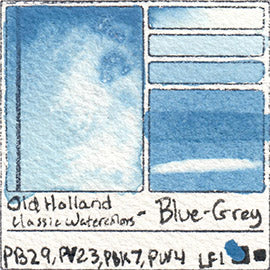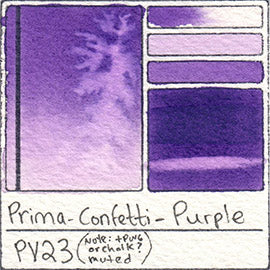VIOLET Art Supply Pigment Database Watercolor Acrylic Ink Pencil Color Chart Swatch
Artist reference guide to Violet pigments in art supplies. Pigment ingredients classified as violet can have a wide color range from red, pink, purple to brown. Color chart swatch cards of common pigments in watercolor, gouache, acrylic paint, inks and pencils. Includes lightfast ratings from the brand (+ fugitive notes if I have conflicting test results). Each image shows the pigment number code (chemical color index), brand, manufacturer color name, how the color appears in masstone (full strength) or diluted (with water),opacity, lifting (erasing with a damp brush), layering (2nd coat after first has dried) and how well it the color could hold a smooth gradient in wet.
PV2 , PV3 , PV14 , PV15 , PV16 , PV19 , PV23 , PV29 , PV32 , PV37 , PV42 , PV47 , PV49 , PV55 , PV62
Natural, antiquity, mineral or unique violet pigments: Purpurite Genuine

PV2 Purple: AKA Violet Light, Vivid Magenta, Purple Lake or Rhodamine CI 45175:1. Fugitive LFIII-V with increased fading in tints/diluted range. This Rhodamine phosphotungstic molybdic acid salt is used for staining cell specimens under a microscope in medical settings. As a cheap lake pigment ("lake" indicating dye that has been attached to an insoluble salt base in order to form a pigment) it is found in low price bargain, student or designer paint sets where lightfastness is not a selling point. More vibrant and magenta leaning than PV3 or PV23.
PV3 M Methyl Violet: AKA Red Violet, Violet Deep, Blue Violet or Spectrum Violet CI 42535:2. Fugitive, LFIV. Slightly toxic, being harmful enough to living cells and organisms that it has been used medically as a disinfectant and fungicide. Darkens over time, sometimes desaturating instead of fading in lightfast tests.
PV3 Mixtures:


PV3:2: A variant of the PV3 Triphenylmethane acid salt. Fugitive.
PV14 Cobalt Violet: Also noted as "genuine", can be both deep or light versions. A very expensive pigment, fairly rare, with minor toxicity. Granulating. Lightfast, LFI, BUT be aware there are environmental reasons that this pigment may fade. This is a lovely pink-purple with heavy granulation that is unique compared to any other pigment, making it valuable in florals and the creation of color separating mixtures. Unfortunately it is not stable in high heat/sunny/humid environments like Florida. It is unclear if this change was due to heat, humidity, chemical or PH changes. Most artists may never experience a problem with this pigment, but be aware that if you sell art that may be hung inside beach front property where daily sunrise/sunset light beams are hotter than northern states the artwork may fade.
PV14 Mixtures:

PV15 Ultramarine Violet: Some brands also offer it as Ultra "Red" which is a muted, dusty pink-purple similar to Ultra Pink PR259. Ultramarine Violet is granulating and lightfast (LFI, BW8). This pigment varies in color from a deep blue, purple to pale pink depending on how it was manufactured (heat a trace elements can change it's final hue dramatically). Overall uncommon, rarely found in student grade paints and the hue is different from each of the handful of manufacturers that carry it. Rembrandt makes a lovely version that has minor color separation with a hint of blue in salt reaction and back runs as well as pink tinges when very diluted. While notably granulating, in practice my Winsor and Newton Ultramarine Violet was even more eager to be textural in wet washes. W&N's is a deeper purple than Rembrandt's, but with a more uniform color. I appreciate both versions for being so clearly different than Ultramarine Blues (PB29).

W&N's U.V. when used heavily in a very wet wash produces incredible texture, shown here as a gradient to Cobalt Violet PV14. If you have seen my video about W&N, I have since updated the swatch card to better reflect wet washes using more pigment. It is easier to achieve a deep masstone using this color fresh from the tube compared to a dry pan.

This granulation is better shown off in larger close up images than the smaller swatch card below:
PV15 Mixtures:





A heavily granulating purple pigment similar in texture to PV14 Cobalt Violet and PR233 Potter's Pink. This pigment is lightfast, LFI, but it can experience chemical changes over time due to interactions with minor acidity in gum arabic binder. In my older tube of DaVinci watercolor, this pigment has hardened into a dark brown blob that no longer reactivates. I have not seen any issue with this paint on paper once dry. I advise using up any paint you have, without stockpiling too far in advance, to use up your supply before any potential changes occur.
PV16 Mixtures:






PV19 Quinacridone Violet:
LFI-LFII fluctuates. Transparent. Also called Permanent Rose or Magenta in many brands. PV19 can come in multiple hues ranging from a cool red to a bluish magenta similar to PR122. Often used as a primary mixing red, as it is capable of bright floral pinks as well as mixing vibrant purples. This pigment is rated as LFII and it takes an average of 6 months or more of direct daily sunlight to case fading. By one year some brands of PV19 have some minor fading, while others are completely unchanged. Of the two main variants - a more violet leaning and a more red leaning option, the red one generally seems to perform better in window tests. If absolute permanence is required, I would suggest looking at individual brand lightfast tests to find the least changed option (such as winsor and newton's results). Technically LFI and LFII paints are both considered lightfast for professional artist use and both PV19 variants are some of the most stable of the magentas and generally red-leaning rose colors. PR19 NOTE: Some brands, such as White Nights, frequently typo PV19 as PR19 on accident (since PV19 looks red instead of violet, it's easy to get confused). These colors are indeed made of PV19 not PR19.




























PV19 Mixtures:
This deep purple pigment can vary in lightfastness by brand. Winsor and Newton, Daniel Smith and Qor watercolors have proven very lightfast. In my one year tests they are on par with LFI to LFII pigments. Has a wet to dry shift, becoming notably lighter when dry. Transparent and glazes well, it can often be layered to reach a near-black masstone.
PV23 Mixtures:















PV29 Perylene Violet:
PV29 Mixtures:

PV32 Benzimidazolone Violet:

PV37 Dioxazine Violet:

PV42 Quinacridone Violet:
PV47 Cobalt Lithium Violet Phosphate:
PV55 Quinacridone Purple:
PV55 Mixtures:


PV62 Strontium Phosphate Violet:
A rare pigment that is similar to Ultramarine Violet PV15 in color and granulation. Lightfast, LFI.

PV62 Mixtures:
Purpurite Genuine: This mineral is mainly manganese phosphate, the natural, impure form of Manganese Violet (PV16). It is not categorized as PV16 due to the addition of trace minerals such as iron. These iron particles can usually be seen as near-black speckling throughout Daniel Smith's Purpurite Genuine watercolor. This pigment is lightfast and highly granulating. It appears to be more stable than PV16 Manganese Violet (purified), which can have browning reactions with binders over time.

Swatch card template available for
download here, or get the
rubber stamp here. Swatch cards were painted on Legion Black or Arches Cold Press 100% cotton watercolor paper. Paper and brushes are available at Jackson's or Amazon here:

I frequently buy my art supplies online at Blick or Jackson's art materials.

I use affiliate links only to places I have personally shopped with for art materials. When available I'll include multiple reputable stores so you can compare and decide where you'd like to shop. Dick Blick ("DB" links below) is a large art supply chain store here in the USA that ships worldwide. Jackson's ("Jack" links below) is a great UK based art supply store which also ships worldwide, but carries some harder to find European products with quick low cost shipping to the USA. Amazon USA ("Ama" links below) often offers unique brands, including small business and Chinese off brand watercolor sets, that can not be found anywhere else. As an Amazon associate, I earn from qualifying purchases.
Arches 100% cotton cold press 140# watercolor paper is one of the most durable surfaces for technical pen, scrubbing and lifting. It's surface sizing (coating) and texture is a good middle ground compared to the extremes of different brands. Due to these traits, and it being around for long enough to be the most commonly recommended paper for professionals, all of my swatches are done on this paper for consistency. Only white (and mica paints that do not show up on white) use the Legion Black paper instead. I buy my arches paper at Blick, and if you are in the USA this is likely the most affordable place to buy it: https://shrsl.com/2765w
Alpha by brand shopping directory:
Daniel Smith watercolors -- available on
DB,
Jack or
Ama.
Interested in other ways to help this project? Visit me at
Kimberly Crick Art on YouTube or
Patreon. If you have supplies that you would like to donate, such as watercolor dot cards or samples from your company that you would like reviewed or displayed in this pigment directory, please email me at enchantedgallery@gmail.com or use the
contact form with details. Thank you :)

Note: this page contains affiliate links. All product opinions are my own. I am committed to honest reviews showcasing both the pros and cons of each product. I have not received payment from any brand for a review. I earn a commission from sales made through this web page's clickable banners or links to Amazon, Arteza, Scrapbook, Jackson's or Blick Art Materials websites.




















































































































































































